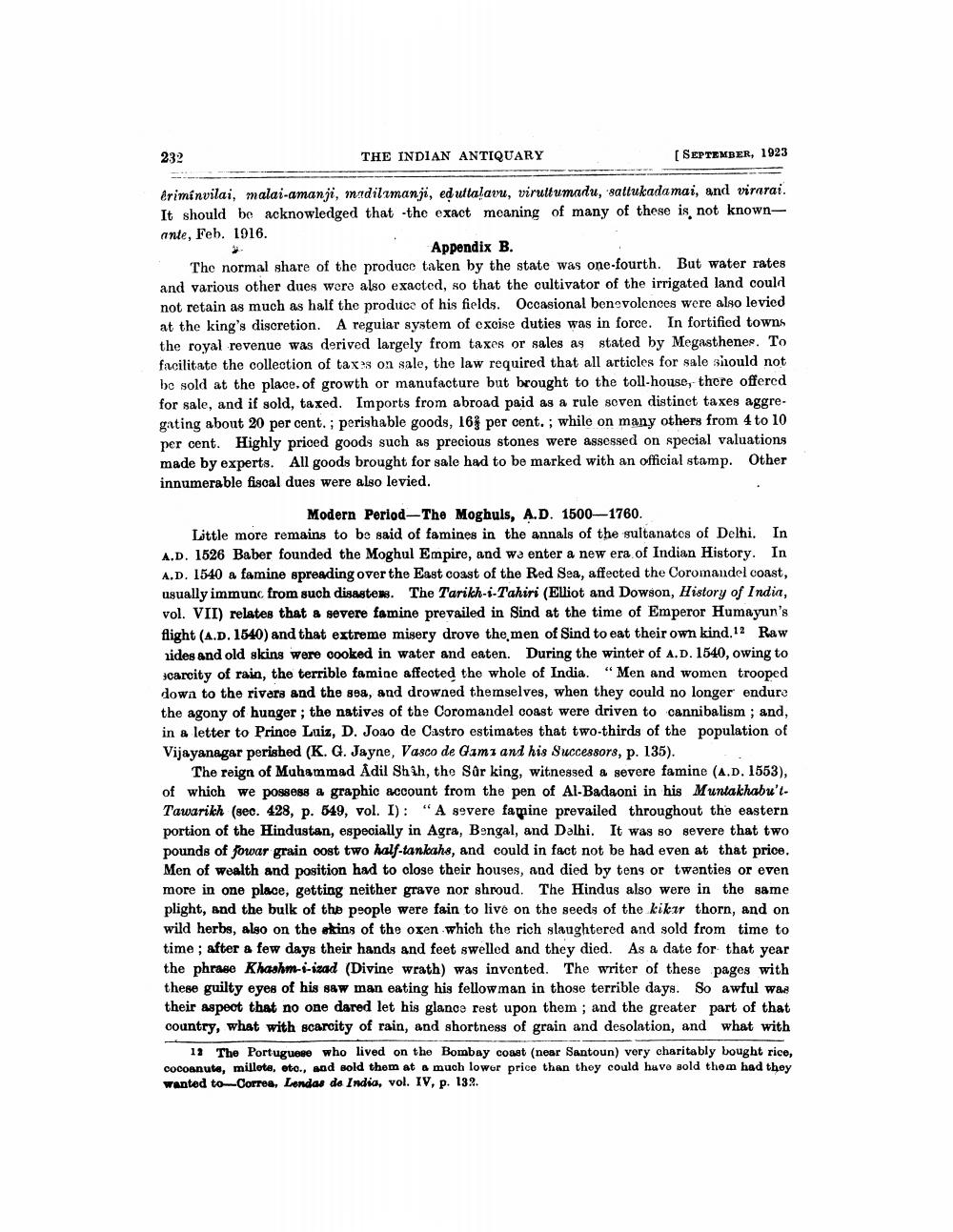________________
232
THE INDIAN ANTIQUARY
SEPTEMBER, 1923
êriminvilai, malai-amanji, madilimanji, ed uttalavu, virutumadu, sattukada mai, and virarai. It should be acknowledged that the exact meaning of many of these is not knownante, Feb. 1916.
Appendix B. The normal share of the produce taken by the state was one-fourth. But water rates and various other dues were also exacted, so that the cultivator of the irrigated land could not retain as much as half the produco of his fields. Occasional benevolences were also levied at the king's discretion. A regular system of excise duties was in force. In fortified towns the royal revenue was derived largely from taxes or sales as stated by Megasthenes. To facilitate the collection of taxas on sale, the law required that all articles for sale should not be sold at the place, of growth or manufacture but brought to the toll-house, there offered for sale, and if sold, taxed. Imports from abroad paid as a rule soven distinct taxes aggre. gating about 20 per cent. ; perishable goods, 163 per cent. ; while on many others from 4 to 10 per cent. Highly priced goods such as precious stones were assessed on special valuations made by experts. All goods brought for sale had to be marked with an official stamp. Other innumerable fiscal dues were also levied.
Modern Period-The Moghuls, A.D. 1500-1760. Little more remains to be said of famines in the annals of the sultanates of Delhi. In A.D. 1526 Baber founded the Moghul Empire, and we enter a new era of Indian History. In A.D. 1540 a famine spreading over the East coast of the Red Sea, affected the Coromandel coast, usually immunc from such disastem. The Tarikh-i-Tahiri (Elliot and Dowson, History of India, vol. VII) relates that a severe famine prevailed in Sind at the time of Emperor Humayun's flight (A.D. 1540) and that extreme misery drove the men of Sind to eat their own kind.12 Raw rides and old skins were cooked in water and eaten. During the winter of A.D. 1540, owing to scarcity of rain, the terrible famine affected the whole of India. "Men and women trooped down to the rivers and the sea, and drowned themselves, when they could no longer enduro the agony of hunger; the natives of the Coromandel coast were driven to cannibalism; and, in a letter to Prince Luiz, D. Joao de Castro estimates that two-thirds of the population of Vijayanagar perished (K. G. Jayne, Vasco de Gami and his Successors, p. 135).
The reign of Muhammad Adil Shih, the Sûr king, witnessed a severe famine (A.D. 1553), of which we possess a graphic account from the pen of Al-Badaoni in his Muntakhabu't. Tawarikh (sec. 428, p. 649, vol. I): "A severe fapine prevailed throughout the eastern portion of the Hindustan, especially in Agra, Bengal, and Dalhi. It was so severe that two pounds of fowar grain cost two half-tankahs, and could in fact not be had even at that price, Men of wealth and position had to close their houses, and died by tens or twenties or even more in one place, getting neither grave nor shroud. The Hindus also were in the same plight, and the bulk of the people were fain to live on the seeds of the kikur thorn, and on wild herbs, also on the skins of the oxen which the rich slaughtered and sold from time to time; after a few days their hands and feet swelled and they died. As a date for that year the phrase Khashm-i-izad (Divine wrath) was invented. The writer of these pages with these guilty eyes of his gaw man eating his fellowman in those terrible days. So awful was their aspect that no one dared let his glance rest upon them; and the greater part of that country, what with scarcity of rain, and shortness of grain and desolation, and what with
12 The Portuguese who lived on the Bombay coast (near Santoun) very charitably bought rico, cocoanute, millete, eto., and sold them at a much lower price than they could huvo sold them had they wanted to-Correa, Lendas de India, vol. IV, p. 132.




